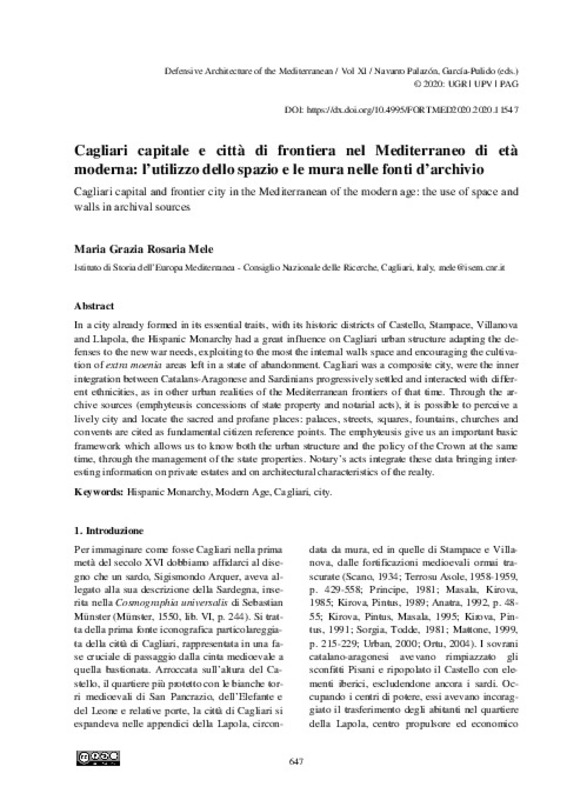JavaScript is disabled for your browser. Some features of this site may not work without it.
Buscar en RiuNet
Listar
Mi cuenta
Estadísticas
Ayuda RiuNet
Admin. UPV
Cagliari capitale e città di frontiera nel Mediterraneo di età moderna: l’utilizzo dello spazio e le mura nelle fonti d’archivio
Mostrar el registro sencillo del ítem
Ficheros en el ítem
| dc.contributor.author | Mele, Maria
|
es_ES |
| dc.coverage.spatial | east=9.1216613; north=39.22384110000001; name=Piazza Ennio Porrino, 427-386, 09127 Cagliari CA, Itàlia | es_ES |
| dc.date.accessioned | 2020-06-23T10:25:14Z | |
| dc.date.available | 2020-06-23T10:25:14Z | |
| dc.date.issued | 2020-05-15 | |
| dc.identifier.isbn | 9788490488560 | |
| dc.identifier.uri | http://hdl.handle.net/10251/146805 | |
| dc.description.abstract | [EN] In a city already formed in its essential traits, with its historic districts of Castello, Stampace, Villanova and Llapola, the Hispanic Monarchy had a great influence on Cagliari urban structure adapting the defenses to the new war needs, exploiting to the most the internal walls space and encouraging the cultivation of extra moenia areas left in a state of abandonment. Cagliari was a composite city, were the inner integration between Catalans-Aragonese and Sardinians progressively settled and interacted with different ethnicities, as in other urban realities of the Mediterranean frontiers of that time. Through the archive sources (emphyteusis concessions of state property and notarial acts), it is possible to perceive a lively city and locate the sacred and profane places: palaces, streets, squares, fountains, churches and convents are cited as fundamental citizen reference points. The emphyteusis give us an important basic framework which allows us to know both the urban structure and the policy of the Crown at the same time, through the management of the state properties. Notary’s acts integrate these data bringing interesting information on private estates and on architectural characteristics of the realty. | es_ES |
| dc.language | Italiano | es_ES |
| dc.publisher | Editorial Universitat Politècnica de València | es_ES |
| dc.rights | Reconocimiento - No comercial - Sin obra derivada (by-nc-nd) | es_ES |
| dc.subject | Fortifications | es_ES |
| dc.subject | Mediterranean | es_ES |
| dc.subject | Modern age | es_ES |
| dc.subject | Built Heritage | es_ES |
| dc.subject | Hispanic Monarchy | es_ES |
| dc.subject | Cagliari | es_ES |
| dc.subject | City | es_ES |
| dc.title | Cagliari capitale e città di frontiera nel Mediterraneo di età moderna: l’utilizzo dello spazio e le mura nelle fonti d’archivio | es_ES |
| dc.title.alternative | Cagliari capital and frontier city in the Mediterranean of the modern age: the use of space and walls in archival sources | es_ES |
| dc.type | Capítulo de libro | es_ES |
| dc.type | Comunicación en congreso | es_ES |
| dc.identifier.doi | 10.4995/FORTMED2020.2020.11547 | |
| dc.rights.accessRights | Abierto | es_ES |
| dc.description.bibliographicCitation | Mele, M. (2020). Cagliari capitale e città di frontiera nel Mediterraneo di età moderna: l’utilizzo dello spazio e le mura nelle fonti d’archivio. Editorial Universitat Politècnica de València. 647-654. https://doi.org/10.4995/FORTMED2020.2020.11547 | es_ES |
| dc.description.accrualMethod | OCS | es_ES |
| dc.relation.conferencename | FORTMED2020 - Defensive Architecture of the Mediterranean | es_ES |
| dc.relation.conferencedate | Octubre 01-03,2020 | es_ES |
| dc.relation.conferenceplace | Granada, Spain | es_ES |
| dc.relation.publisherversion | http://ocs.editorial.upv.es/index.php/FORTMED/FORTMED2020/paper/view/11547 | es_ES |
| dc.description.upvformatpinicio | 647 | es_ES |
| dc.description.upvformatpfin | 654 | es_ES |
| dc.type.version | info:eu-repo/semantics/publishedVersion | es_ES |
| dc.relation.pasarela | OCS\11547 | es_ES |








